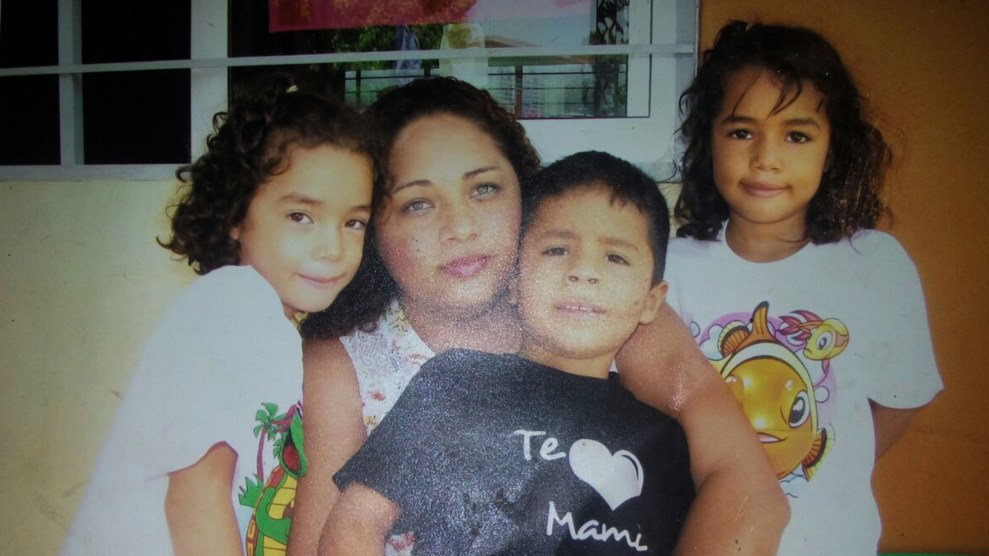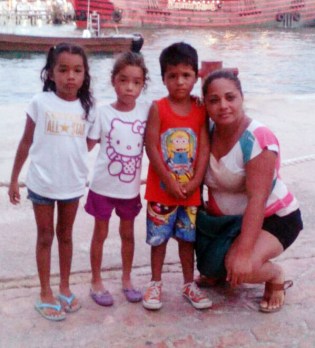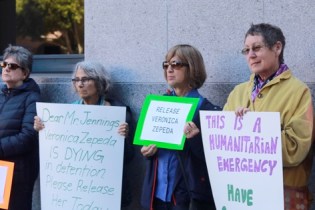
Veronica Zepeda and her children.Courtesy of Niloufar Khonsari
Update, July 28: Veronica Zepeda will be released today from Mesa Verde Detention Facility. After more than 100 supporters from faith-based organizing networks showed up to her bond hearing, San Francisco immigration judge Dana Leigh Marks ruled that Zepeda, appearing via videoconference, should be released on her own recognizance, meaning that she won’t have to pay the typical $1,500 bond to be released from detention. “I’ve never seen that before,” said Luis Angel Reyes Savalza, the Pangea lawyer representing Zepeda at the hearing. In the courtroom, he says, “the level of community support was overflowing. People were standing, sitting on the floor.” After she gets medical clearance to travel, Zepeda will move to Houston, where her sister and friend live. Her case will move to the Texas immigration court docket—so she’ll get at least two more years to prepare for her withholding hearing, Reyes Savalza estimates. “[Veronica was] visibly in tears and crying,” he says. “She’d never thought that someone who’d gone through so much abuse could get so much support.”
The last time Veronica Zepeda was home in Mexico’s southern state of Chiapas, her children tried to warn her she was in danger. Zepeda, though, already knew. Born and raised in El Salvador, the blue-eyed, 29-year-old mother of three had spent years enduring physical and emotional abuse from her husband, Julio, and his family. Her father-in-law regularly called her “whore,” “indigenous,” and, in a jab at her lack of formal education, “illiterate.” Julio beat her weekly, sometimes with a metal poker, once so hard that he left a scar. He’d repeatedly threatened to take their children away from her, grabbing the kids and their passports and driving off. For a long time, the children had been too young to notice the bruises on their mother’s face and body and understand what was happening. But now—ages seven, eight, and nine—they’d seen too much. Our daddy doesn’t like you, they said. And: Mom, you need to go.
So Zepeda went. “I didn’t want them to see me like this,” she explained to Niloufar Khonsari, a San Francisco-based immigration attorney and executive director of Pangea Legal Services, the group representing Zepeda. (Mother Jones is withholding part of Zepeda’s name, as well as Julio’s surname, to protect her from retaliation.) Leaving her children behind, Zepeda traveled more than 2,000 miles to the US border and crossed the fence near San Diego, California, in late January 2017. She’d tried to enter the United States before—twice she was deported by Immigration and Customs Enforcement (ICE)—but she still believed returning might lead to a better life for herself and, potentially, for her children.
She was caught just over the border. In ICE custody, she convinced an asylum officer that she might be in danger if she returned. That interview was enough to spare her immediate deportation—but not detention. According to Obama-era guidance, ICE recommends its agents exercise “particular care and consideration” when deciding to detain people who’ve experienced domestic violence. Still, instead of releasing Zepeda as she sought legal protection, ICE incarcerated her.
Six months later, she is still locked up in Mesa Verde Detention Facility, a Bakersfield, California, immigrant detention center run by one of the country’s most powerful private prison companies. Mother Jones has reconstructed Zepeda’s path to and experience at Mesa Verde based on documents submitted as part of her immigration case, medical records, a translated interview with Zepeda, and interviews with her lawyers. What emerges is a complicated case for sanctuary in the United States—centered on an immigrant who has faced persecution in two different countries, both El Salvador and Mexico, and has already tried multiple times to cross the US border. Her history as a survivor of domestic violence only makes matters more complicated.
In 2014, ICE detained 44,270 asylum-seekers in its sprawling immigration detention system. There’s no record of how many of them are women fleeing gender-based violence, according to Karen Musalo, director of the Center for Gender and Refugee Studies—and no way to know how many more have been deported back to danger, like Zepeda was. But the number of US asylees from El Salvador and Mexico has soared over the past few years, from a combined 609 people in 2013 to more than 3,000 in 2015, and levels of violence against women in both countries remain endemic.
Legally, women fleeing domestic violence face a system that, until recently, questioned whether they could be considered asylum-seekers at all. And when they are allowed to pursue asylum, they’re often held for months in detention centers that can exacerbate the psychological symptoms of trauma. Under President Donald Trump, these problems seem likely to worsen. Just consider the administration’s executive order on border security from January: To comply with it, the Department of Homeland Security issued guidance that some fear will limit access to asylum and make it even more difficult for asylum seekers to secure release from detention. Zepeda’s attempts to find refuge highlight the pitfalls of an immigration system that can—and often does—fail the most vulnerable.

Zepeda was born in Sonsonate, El Salvador, one of the bloodiest departamentos in a country with the world’s fifth-highest homicide rate. According to a statement from Zepeda, which was prepared and translated by Khonsari and is being filed with US immigration authorities as part of her request to be paroled from detention, when she was a child, she labored in fields for her father, who beat her and forced her to sleep outdoors when she didn’t accomplish enough in a day. There were some better times, too: Occasionally she’d bring home seafood to share with her brother and his friend, whom they called El Choco, as the boys did homework together.
But the gang MS-13 was active in their area. One day, when she was a teen, Zepeda was getting off a bus when she saw El Choco standing in front of a store. A man she knew as Araña, “spider,” was holding a gun to his head. According to her statement, she saw Araña execute El Choco, and Araña saw her witness it. “You could be worse off,” she remembers him saying, if she didn’t keep quiet about the identity of El Choco’s killer. “You and your whole family.”
It wasn’t long before Zepeda decided she needed to leave El Salvador. Other MS-13 members were continuing to threaten her, while El Choco’s mother was urging her to tell the police what she’d seen. Around 2005, she ran north to Guatemala, and then, with the help of a woman she didn’t know, into Mexico, where she was left at a cantina near the border and instructed to wait for the stranger to come back.
The woman didn’t return. Instead, one of the cantina owners gave Zepeda a miniskirt, high heels, and a tight top. “She told me to get dressed and told me I could make a lot of money,” Zepeda says in the statement. But when she refused to have sex with customers, the women who owned the cantina retaliated by confining her inside without food. And there were darker abuses. “They hurt me over and over in a way that I don’t want to remember,” she says in her statement. “There was a lot of blood from my privates. I was dying of starvation.”
It took eight days for her to get out with the help of a man who visited the cantina. He gave her his number and helped her escape. It was Julio. At first, he paid for her to stay in a safer location, but soon she moved in with him. They’d remain together for the next eight years.
In her statement, Zepeda says that Julio started to abuse her just months into the relationship, and that she could expect a beating at least once a week. “I never called the police because I was scared they would send me to El Salvador,” she says through Khonsari. “I thought I was better off suffering with him than returning because I didn’t want to be killed.” As the years went on, her two daughters and son served as a reprieve. “My kids are the most valuable thing in my life,” she wrote recently in a translated letter to advocates working to get her released from detention. “A beautiful gift from God.”
Zepeda, unfortunately, is far from unique; women in the Northern Triangle of El Salvador, Guatemala, and Honduras, as well as parts of Mexico, experience pervasive violence. According to the United Nations High Commissioner for Refugees (UNHCR), women were murdered at a higher rate in El Salvador in 2015 than in any other country; an estimated 77 percent of killers of Salvadoran women in 2013 never faced punishment. In Mexico, meanwhile, nearly 63 percent of women can expect at some point in their lives to experience domestic violence. Like Zepeda, many of these women stay silent. According to a 2015 UNHCR report based on interviews with 160 women from the Northern Triangle and Mexico who sought sanctuary in the United States, 40 percent of them never reported the violence or threats they experienced to the police, believing that the authorities wouldn’t or couldn’t respond sufficiently because of the local control of gangs.
By 2012, Zepeda couldn’t take it any longer. Just as she had as a teenager, she ran north: across the border into Texas, where she lived in Houston for more than a year undetected by US immigration authorities. But Julio eventually cut off contact with her kids, and she felt she had no choice but to return to Mexico. “I thought I could make things right,” she says in her statement. When she returned, she quickly discovered that Julio hadn’t changed, and fled again. She attempted to cross the US border into Texas twice, in 2013 and 2014. On both attempts she was caught quickly, her lawyers say, and deported to El Salvador.
Zepeda maintains that the first time she was taken into US custody, she told an immigration agent that she was afraid to return home. That should have been enough to earn her the chance to tell her story to an asylum officer in a “credible fear” interview—the first step toward applying for asylum.
She never got that opportunity, though it’s not clear why. She may not, in fact, have expressed fear, or it’s possible the Texas agents speaking with her may not have recorded it. So instead of being treated as an asylum-seeker, according to her lawyers, Zepeda was given a final removal order in 2013 through ICE’s “expedited removal” process, which allows low-level officers to sign off on some deportations without a hearing in front of an immigration judge.
Another Pangea lawyer, Juan Camilo Méndez Guzmán, believes Zepeda wasn’t treated as an asylum-seeker the first time she was caught because, he says, “I don’t trust that the border agents did everything that they could to ask her about her fear.” Advocates working on behalf of immigrants have long expressed concern that immigration authorities regularly deport potential asylees without giving them a chance to take a credible-fear interview. In a class-action lawsuit filed against Customs and Border Protection earlier this month, immigrants who had been denied access to the asylum process allege that potential asylees have been rebuffed at the border and told, falsely, that “Donald Trump just signed new laws saying there is no asylum for anyone.” In 2014, the American Civil Liberties Union examined 89 border cases in which individuals were deported without a hearing—and found that more than half were never asked in a language they understood whether they feared persecution before they were deported, while 1 in 9 had expressed fear to agents but were never referred for an interview.
What makes things even more murky for Zepeda specifically is that the first time she was apprehended, it was still unclear whether domestic violence victims could even qualify for asylum, according to Musalo. Under US law, people applying for asylum have to demonstrate they have been or will be persecuted for characteristics they can’t control—race, religion, nationality, political opinion, or membership in a “particular social group.” Not until 2014, after Zepeda had already been deported twice, did the top US immigration court recognize that domestic violence victims could qualify as a kind of “particular social group” facing persecution. The court’s decision looked at the case of a Guatemalan woman who sought asylum in the United States after being raped and repeatedly beaten by her husband. Before she fled, the local police told her they would not get involved in a marital relationship, and when she tried to move away, her husband pursued her. The decision that she was eligible for asylum—as a “married [woman] in Guatemala who is unable to leave the relationship”—was a turning point in a decadeslong battle to get US immigration courts to recognize the claims of women facing gender-based violence, Musalo says.
Zepeda’s final removal order meant that she was sent back twice to a country where she knows, through her sister, that MS-13 has continued to ask about her by name. After each deportation, she returned to her father’s house—and each time, according to her statement, he hit her. In 2014, she says in her statement, “I told [my father] that Julio was violent with me. My father then beat me twice with his belt and struck me with his hands…He told me that I was stupid and irresponsible for leaving Julio.” Each time, she left her father and went back to Chiapas, and to her children.

Zepeda’s supporters rally outside the San Francisco immigration court.
Courtesy of Lisa Marie Wong
After returning to Chiapas in 2014, Zepeda spent more than two years there before she decided to leave at her kids’ urging. “They are the ones who gave me the courage to try to leave Julio a final time, and seek security in the United States,” she says in her statement.
When Zepeda was caught crossing into California in January, her interaction with ICE played out differently. An immigration agent finally referred her to an asylum officer for an interview, which she passed. The bad news was that her removal order meant Zepeda was no longer eligible for full asylum. Instead, she was put under consideration for a kind of second-class asylum status known as “withholding of removal”—an indefinite reprieve that would allow her to stay in the country, but with fewer rights. That’s now the best she can hope for.
For now, she remains inside Mesa Verde. The 400-bed detention center is run by the for-profit prison company GEO Group, the nation’s largest private detention center operator, which earns at least $94.95 for every day she’s detained. Inside the facility, Zepeda cleans showers and toilets five days a week for $1 a day. “It’s $5 to call my kids,” she explains in an interview. “I call them once a week to know how they are doing, so that they know how I’m doing.”
Recently, though, she has begun to worry that she may never get out of detention. When she was processed into Mesa Verde, she was given acne medication for her skin, Tylenol for headaches, and an otherwise clean bill of health. Then, over the past few months, she began to show more serious symptoms. At least four times she has suffered fainting spells, often accompanied by severe headaches and chest pain—episodes that required her to be transported to the nearby hospital. Once, she says, she woke up in an ambulance, bewildered. “I was like, where am I? Where are they taking me? What is happening to me?” she says in an interview. “I felt like I was dying.” Another time, she was found lying on the floor in the dormitory and was brought to the facility’s medical unit, where her blood pressure dropped so low that the detention center’s nurse couldn’t locate a vein for an IV. Zepeda has received some tests, including an MRI and cardiology exam, but she still says that she hasn’t gotten any answers. At first, the GEO medical staff chalked it up to a bad reaction to Benadryl. Later, the detention center psychologist concluded it might be related to “stress and depression” due to her “lengthening stay” at Mesa Verde.
“I’m really worried because I don’t know what’s going on,” she says in an interview. “I wouldn’t like, if I died, for no one to know. My kids have the right to know what’s happening.”
Despite Trump’s January executive order, Homeland Security does allow ICE to exercise discretion to release some detained immigrants for “urgent humanitarian reasons or significant public benefit.” Last month, Méndez Guzmán urged ICE to release Zepeda so she can seek better care “given the potentially critical medical issue, the past trauma and violence Veronica suffered, the lack of any criminal record, and the strong avenues for legal relief.” But on July 17, the agency declined the request. Her next chance at release will come at a bond hearing on Friday, where she’ll appear in front of a San Francisco immigration judge via videoconference from nearly 300 miles away. If that fails, she’ll remain in detention until a withholding hearing on August 18.
Meanwhile, the Pangea lawyers have enlisted help from groups like Faith in Action Bay Area, a local organizing network that arranged a rally for Zepeda outside the immigration court last week, and PICO California, another faith-based activist group that sent an organizer to visit her in Mesa Verde. The legal team has gotten Bishop William Justice of the Archdiocese of San Francisco to call ICE’s field office director on her behalf. They are also continuing to help her prepare her withholding application, in which she’ll apply for sanctuary as a member of several persecuted social groups, including “Salvadoran women seen as property.”
Even if she ultimately wins her withholding case, Zepeda won’t be permitted to apply to bring her children to the United States—a possibility only for full-fledged asylees. If they’re ever to join her, her two daughters and son will have to make their own way. But she still believes that the United States will one day help her provide for her children, escape her past, and, as she put it in that recent letter from Mesa Verde, to “move forward.”
“No seré abusada ni humillada más,” she wrote: “I will not be abused and humiliated anymore.”
This story has been updated.


















